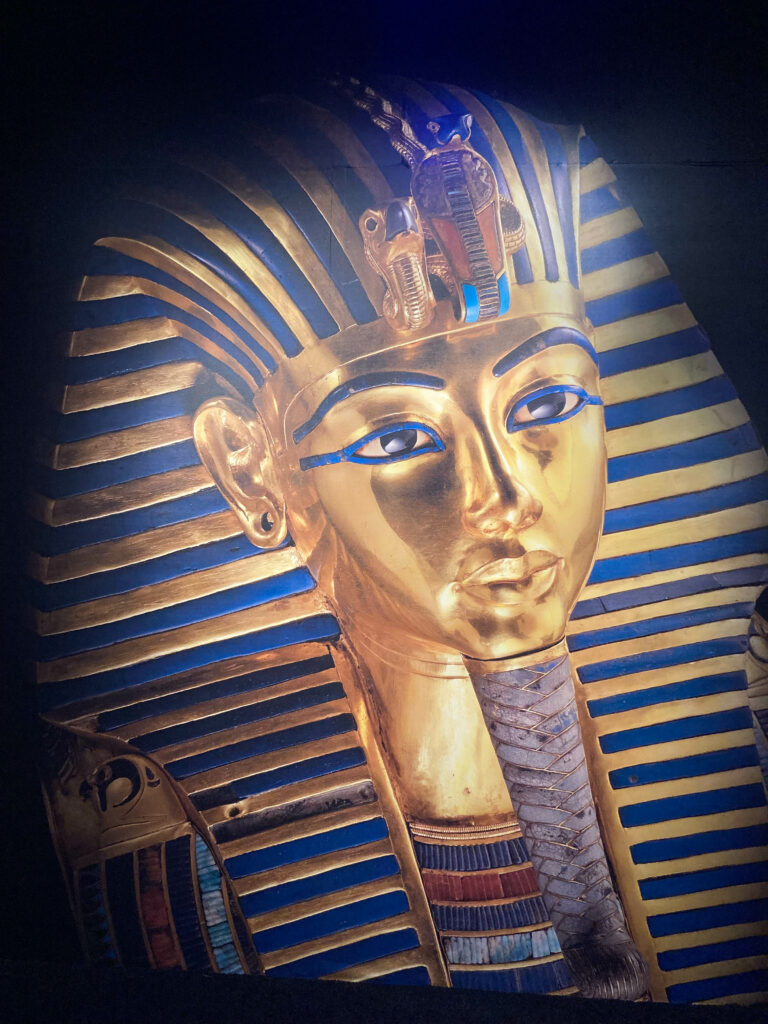An unmistakeable mask. A 3,000-year-old precursor to backgammon. A mummy, encased in three sarcophagi, within four shrines. All on display in Washington, D.C.
Well, sort of.
This post contains affiliate links. For more information, click here.
On November 26, 1922, British archaeologist Howard Carter opened the nearly intact tomb of the now legendary boy-King Tut. Accompanying him was his financial backer, the fifth Earl of Carnarvon, and his daughter Lady Evelyn Herbert. (The Carnarvon home is Highclere Castle, the setting for Downton Abbey.)
The discovery ignited an enduring fascination with ancient Egypt.
If you’d like to view the astonishing array of artifacts the tomb housed, you’ll have to wait for the opening of the Grand Egyptian Museum in Giza, now slated for some time next year.
But in the meantime, the next best thing might be “Beyond King Tut: the Immersive Experience” — a virtual journey through the tomb and along the late monarch’s mythological passage to the afterlife. I went a few weeks ago with a group of friends.
After a short introductory film, visitors move through a series of rooms and passages filled with facts about the ancient king’s life and the modern discovery of his tomb.
Tutankhamun was around nine years old when he became king c. 1332 B.C. and about 19 when he died. His exact cause of death is uncertain, but historians believe that malaria, or an infection from a broken leg, or a combination of the two, is likely. He also had a number of life-long health problems, likely the result of inbreeding, including a clubbed foot, a cleft palate, and a curved spine.
Almost 5,400 objects were found within his tomb, including canes, chairs, chariots, and amphorae. The exhibit features a mix of high-res photos from National Geographic’s archives and replicas of the artifacts, including Tut’s iconic blue-and-gold death mask and his gold-plated exterior shrine, which contained his mummy within three sarcophagi, within three interior shrines, layered like Russian nesting dolls. There’s also a detailed section about the 70-day mummification process, which included washing the eviscerated body with water and wine.
The young people in our group enjoyed playing senet, which is similar to backgammon and was one of five board games found in the tomb.
But the real showstopper is the animated film depicting Tut’s mythological journey after death. It’s projected floor-to-ceiling on all four walls of a large room, giving viewers the sense of being right there in the middle of Tut’s quest.
The ancient Egyptian belief about the afterlife was complex, and unsettling. The soul had to battle its way along a dangerous journey. Its guide was Anubis, the jackal-headed god of the dead.
Tut’s soul would travel by boat through a realm populated with strange beasts toward the Land of the Gods.
Tut would have to get past gates guarded by monstrous creatures like fire-breathing serpents.
If he made it through, he would face judgement day and stand trial before the gods, who would weigh his heart against a feather. If his heart was lighter, he would become immortal. If the feather was lighter, he would be eaten by a beast. Ancient Egyptians believed he passed the test.
After going through the exhibit, it’s even clearer why Tut continues to intrigue. He was very young. He sufferred. He died mysteriously. He lived and was buried with astonishing wealth. Though entombed with canes, he was expected to survive a Herculean quest in order to save his own soul. And he’d remain lost to memory if his tomb hadn’t been built to last forever, and discovered 100 years ago.
What to Know before You Go to
Beyond King Tut:
the Immersive Experience
As of this writing, “Beyond King Tut: the Immersive Experience” is open through February 6, 2023, at the National Geographic Museum at 1145 17th Street NW in Washington, D.C.
The closest Metro stop is Farragut North on the Red line. There is no parking at the Museum, though there are several pricey garages nearby, as well as some street parking.
The Museum has a small gift shop with unique items.
Allow 60 to 90 minutes.
Excellent hotels within walking distance include:
In addition to Washington, “Beyond King Tut: the Immersive Experience” is currently live in New York, Los Angeles, and Vancouver and slated to open next year in San Diego, San Francisco, Houston, and Atlanta.
After my misspent youth as a wage worker, I’m having so much more fun as a blogger, helping other discerning travellers plan fun and fascinating journeys. Read more …

